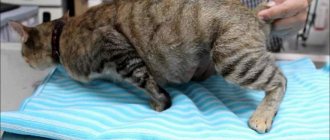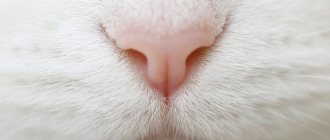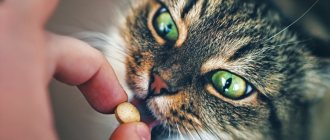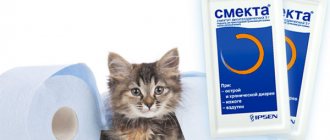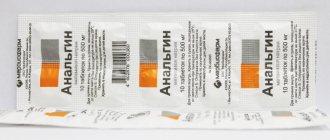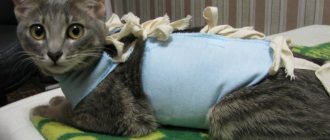What signs can you use to know that a cat is about to give birth?
A cat, just like a person, has certain signs that indicate impending birth:
- The animal is constantly kept in a box or on a bedding specially designed for childbirth.
- The cat moves around the house only to drink food or water, the rest of the time it lies and sleeps.
- If the owner gives hard and heavy food, she may refuse it completely, as an overfilled stomach leads to discomfort or pain.
- The external genitalia swell and become red.
Pregnant cat
- A small amount of red or yellow mucus may be released.
- Reddening of the nipples, the beginning of colostrum secretion, this indicates the established process of lactation.
- A few hours before the cat lambs, her mucous plug comes out, this indicates the beginning of the birth process.
- At the beginning of active contractions, the cat begins to meow loudly and protractedly.
- Often the animal tries to leave the family place, to hide from people, this should not be allowed so as not to harm the offspring.
Important! To avoid unpleasant consequences, you can first agree with a veterinarian to provide assistance during labor. There are clinics where a doctor can visit your home even at night.
How to help a cat give birth at home
Pregnancy in a domestic cat is relatively quick, lasting 55 to 60 days. Some individuals give birth completely independently and human participation in this process is not important to them. British cats, Sphynxes, Maine Coons or Persians require the obligatory assistance of the owner during childbirth or even the presence of a veterinary obstetrician.
It is advisable to know exactly how much time has passed since the moment the animal was mated, in order to be prepared for the required time.
The approach of “day x” will be indicated by the so-called harbingers of childbirth, during which the expectant mother is a cat:
- begins to look for a secluded place to build a nest;
- becomes very affectionate with a person, requires special attention to himself;
- may refuse to eat;
- begins to lick the swollen mammary glands.
A few days before the expected birth, you need to prepare the necessary list of things that may be needed to help the cat and her cubs:
- Childbirth box. Place in a secluded, warm place;
- Disposable diapers and sterile wipes;
- Disposable syringes and medications if there is a possibility of complications;
- Vaseline oil;
- Sharp scissors;
- Disinfectant solution;
- Surgical or silk thread to tie the umbilical cord;
- Iodine or brilliant green.
When a cat may need help
How to measure a cat's temperature at home
When contractions begin, unforeseen circumstances may occur. If a cat cannot give birth, not every owner knows what to do at home.
There are possible complications that will require the owner's help:
- weak contractions in a cat, due to which the birth process cannot begin;
- lack of discharge of the mucus plug;
- long contractions that exhaust the animal’s body, which leads to difficulty in releasing the fetus;
- lack of cervical dilatation;
- entanglement of the kitten’s umbilical cord, which can cause it to be stillborn;
- incorrect location of the fetus, which makes it difficult to pass through the birth canal;
- the presence of blood or green or black discharge, which may indicate infection or tissue damage;
- large fetuses that cannot pass through the birth canal without outside help.
A qualified veterinarian will tell you what to do if a cat gets stuck with a kitten during birth, or other consequences occur. A prepared owner will be better able to cope with complications.
Your help in giving birth to a cat
Labor begins with the breaking of water, loud meowing and similar signs. Don’t rush to interfere - if the cat can handle it on its own, this will be an ideal option. Kittens may be born slowly, but note the time - if more than an hour passes, you need to urgently call the clinic. If a kitten gets stuck in the birth canal, your help will be needed. We will pull it out, but do it very gently and not by the paws or head, but by the skin in the withers or back area. If the kitten comes out with its hind legs, there is no need to grab - this is the veterinarian’s job.
If a kitten was born in a bubble, but the cat is in no hurry to release it, perhaps does not even know that she should do this, you must save his life. To do this, you need to cut or tear the bladder, then you need to clean its airways, and then cut the umbilical cord and tighten it with a thread. All this needs to be done in about 5 minutes, or better yet 2-3 minutes, so be prepared. After clearing the respiratory tract, you need to coat the umbilical cord with iodine to prevent germs from entering, and then vigorously and quickly rub the kitten with a towel - you need it to squeak and show a sign of health and energy. When it beeps, we apply it to the cat’s mammary glands.
Stimulation of labor in cats and preparation for it
If the animal has weak labor, the veterinarian may resort to medications that will stimulate the function of the uterus. It will begin to contract, which will lead to the activation of labor and the normal passage of fetuses through the birth canal.
How to help a cat in the heat: examples of what you can do
The most suitable drug is Oxytocin. This is a natural hormone that causes the uterus to contract. Its dose is calculated depending on the cat's weight. For example, if it is 5 kg, 0.3 ml is administered every hour. But there is a ban on using it more than 4 times for one animal.
Important! Increased contraction of the uterus can lead to exhaustion of the body, blockage of the birth canal and fainting.
How to prepare for childbirth
The first thing you need to do before giving birth is to prepare the “ward”. This is where the cat will give birth, and where she will spend the next few weeks with her kittens. Typically, cat owners equip a regular cardboard box as a birthing area.
When choosing it, you need to be guided by the following indicators:
- Accessibility means that you cannot take a box with high sides, or you just need to cut it off. Since it will be extremely inconvenient for a woman in labor to climb over high barriers;
- Size – it should not be too small or large. Expect that the cat will move around inside it, and then live with the kittens;
- Position – Place the structure in a quiet place so that the cat has some space of its own. This could be a closet, a corner of the bedroom, a bathroom, or other unoccupied areas of your home.
If you do not create a special place, or your cat does not like it, she will run after you or hide in a place where you cannot help her, which will endanger both the mother and her offspring. There should be bowls for drinking and food nearby, as well as milk powder for kittens. It is better to move the cat's litter box closer.
"Alarm suitcase"
In order for you to be prepared in that very case, collect an “Alarm Suitcase” in advance (as with women during childbirth). The contents of the suitcase may be different, depending on your capabilities and competencies. These are mainly: surgical gloves, sterile towels and tissue, cotton wool, wet wipes, medical thread, pipette, bulb or small syringe. As for medications, you should put in there a liquid antiseptic, healing ointments like Levomikol, Vaseline, oxytocin, potassium gluconate, and other products.
What to do during childbirth
So, you have prepared the place for the birth, the cat is in place, the “Alarm suitcase” is at hand. You see that the cat has begun to arch, you can feel with your hands how the abdominal muscles are contracting - these are contractions. Usually, after 1.5-2 hours of active contractions, the first fetus appears.
IMPORTANT: If more than two hours have passed since the start of active contractions, the cat is straining, she has brown discharge, but there are still no kittens, then this is a reason to contact a veterinarian. This situation occurs when kittens are stuck and cannot get out.
When should I start reporting? The first signs of the onset of labor
- The cat's stomach drops;
- She begins to urinate frequently and her water breaks;
- The birth plug separates and discharge begins;
- Naturally, the cat begins to breathe frequently.
If you observe these symptoms, labor has begun. Under normal natural conditions, cats give birth on their own. But you should be on your guard, because at any moment something can go wrong.
What to do if your cat can't give birth
How to trim a cat's claws: options at home
If the animal is unable to give birth on its own, even under the influence of Oxytocin, the doctor may resort to a last resort - a caesarean section. Many owners are afraid of surgery, but it is considered the safest method of treating fetuses without risking the life of the animal.
Attention! Caesarean section can only be performed in a clinical setting, as this requires sterile conditions, special instruments, medications and a resuscitation kit if necessary.
The procedure is carried out in several stages:
- they use general anesthesia, during which the cat falls asleep and cannot move;
- the peritoneum and uterus are incised;
- the fruits are removed along with the amniotic sacs and placenta;
- suturing the uterus and abdominal wall;
- use an antiseptic to eliminate the risk of infection;
- waiting for the hypnotic effect to end.
If the pregnancy was accompanied by serious complications during surgery, the doctor may recommend removing the ovaries and uterus. This prevents the possibility of further complications such as bleeding, as well as further unwanted offspring.
After the operation, it is advisable that the woman in labor stay in the clinic for another 2 or 3 days. When she begins to recover, she will be given to her owner.
Licking a kitten
How to understand that a cat will give birth soon
When there is a pregnant cat in the apartment, its owner is waiting for new offspring. While waiting, a natural question may arise for the pet owner: when will the moment of birth itself come and how can the pet be helped and facilitate this process. Indeed, this issue will require some practice.
We recommend reading: The dog has scratching and irritation abrasions around the loop
Any experienced cat breeder or veterinarian will know the answer to this question and can give a detailed answer. But even a beginner can cope with this task; you just need to study the characteristic features of labor inherent in cats.
First, let’s answer the question: how long does pregnancy last in cats? The gestation period for a healthy cat is about 65 days. After this, the cat must give birth to kittens. Therefore, every pet owner should know the approximate time for the onset of cat birth.
As for the signs that indicate that a cat will soon begin to give birth, in some individuals they appear two days before giving birth, and in others literally two hours before the crucial moment.
The maturation of each cat is an individual moment. The course of pregnancy is also individual. There are cats that worry and look for a cozy and secluded place in advance, and there are those that begin to understand what is happening to them only when the birth itself begins.
About seven days before the onset of birth, the owner of the animal should pay more attention and observe the cat more. Then moment X will definitely not be missed.
What to do if the kitten is born too big
If you have a large fetus, it is recommended to choose one of the following methods for delivery;
- removing the kitten using forceps;
- C-section.
The first method can lead to unwanted complications for the kitten. For example, a leg may break because the muscle and bone tissue is not yet sufficiently developed. Therefore, doctors more often recommend surgery.
Cat with newborn kittens
Freeing the kitten from the amniotic sac
When the fetus is delivered along with the amniotic sac, it is recommended to apply the following rules:
- Do not pull on the umbilical cord, as this may cause a hernia.
- The umbilical cord is cut with sterile scissors with blunt ends 1 cm before the kitten's abdomen.
- The umbilical cord area is cauterized with iodine.
- If the cat does not lick the kitten, rupture the amniotic sac in the area of the kitten’s nose and suck out the fluid from the nose and mouth using an enema.
- They give the newborn to the cat so that she can lick it and apply it to the nipple.
- The placenta is counted, since each of them may not come out immediately after the kitten, but after some time.
Attention! It is extremely important to count the placenta, as if parts of it remain inside the uterus, this will lead to infection and possible death of the animal.
Newborn Sphynx kittens
What not to do during childbirth
Not all owners are aware of the ban on a number of actions during childbirth that can lead to side effects for the woman in labor:
- press on the stomach, as this can cause severe pain and harm the fetus;
- pulling the umbilical cord, which can break or lead to a hernia;
- burst the bubble yourself if the cat is able to do this;
- pick up kittens from animals that require licking and breastfeeding;
- use contaminated instruments that may cause infection;
- inject yourself with various drugs without a doctor’s permission;
- stimulate the labor process with medications if it is proceeding normally.
Not every owner knows what to do if the cat’s birth had complications, or how to help in this situation. It is better to consult a doctor who can count all the placenta, determine the time of birth, and speed up the process if necessary.
Third stage of labor
The third stage of labor is the state of calm of the cat's uterus in the interval between the birth of babies. It lasts about fifteen minutes. During this period, the cat can drink some water. Often the cat also eats the afterbirth, which comes out after the kitten is born. But you should not allow your pet to eat more than two afterbirths. This can cause stomach upset for the new mother.
INTERESTING: The number of placenta during childbirth in cats should be the same as the number of kittens born. If the placenta does not come out, the owner needs to help his pet remove it. If this is not done, the cat may develop serious inflammation.
It is impossible to accurately determine the duration of labor in cats, because this is a very individual process. There are individuals who cope within a couple of hours, and for some, prolonged labor lasts up to 36 hours.
How to care for a cat after giving birth
Immediately after the birth is completed, all afterbirths are eliminated, the animal’s body is exhausted. Therefore, we need to help him during this period:
- Provide clean water at all times to prevent dehydration.
- Feed soft, easily digestible food to normalize the digestion process, especially for cats after cesarean section.
- Keep your pet in clean conditions, change the bedding daily. Monitor the presence or absence of discharge - it can be profuse, mixed with pus if there are complications.
- Ensure peace and do not disturb the cat.
- Contact the veterinarian 1-2 times for a general examination and undergo laboratory tests as necessary.
Attention! If the cat is weak, a tray and feeder are placed next to its bedding so that it does not have to move around the room.
Helping a newborn kitten
When the fetus is born, it is surrounded by a bubble of amniotic fluid. If the cat does not lick the kitten on its own, you need help getting out of the bubble. Since the kitten has been in liquid for a long time, its mouth contains liquid. It needs to be sucked out using a pipette or a small enema.
If a cat gives birth to a kitten butt first, damage to the kitten's limbs may occur. In this case, you cannot do without the help of a veterinarian. You cannot try to fix the limbs on your own; giving medications is not recommended.
Important! After removing the kitten from the amniotic sac, it is given to the mother for licking and feeding. This is where a person’s actions end.
Kitten after being removed from the bubble
Possible complications after childbirth
If the birth was difficult, the following complications may occur:
- excessive bleeding, in which the animal requires a blood transfusion;
- damage to the tissue of the uterus or birth canal;
- severe exhaustion of the woman in labor;
- stillbirth of kittens;
- infection of the birth canal or uterus;
- the remainder of the placenta in the uterine cavity.
In most cases, it is impossible to independently identify and eliminate complications. That is why it is recommended to undergo examination at the time of birth and within 1 week after it.
When to urgently contact a veterinarian
After giving birth, the cat should gradually recover. She gains strength, she begins to move around and feed her offspring.
But there are cases when the animal becomes lethargic for a long time, and discharge forms in the genitals. The pet refuses to eat. This is a reason to contact a veterinarian. The cat's body temperature may rise greatly and convulsions may begin. All this can lead to her death if timely treatment is not started.
Childbirth is a natural process for cats, but in some cases it is complicated. Therefore, the owner needs to know what to do during this period. This applies to any pet, be it a purebred British cat or an ordinary yard cat. Complications may occur during the first or each subsequent birth.
How to Make a Cat Give Birth Faster
PREPARATION FOR CHILDREN
If the owner of the animal does not take care of the “nest” for the cat, she will find such a corner on her own, which does not always coincide with the owner’s wishes. Therefore, it is necessary to prepare in advance a box or box large enough for the lying mother and the young. The optimal size for the house is 50x50x20 cm. Experienced owners make a shelter, with a removable top cover, this allows the cat to realize its need to be enclosed on all sides. The entrance should be located at a distance of 10 cm from the bottom of the box. It is best to line the bottom of the “house” with washable porous rubber, and lay an easily washable fabric on top. You can use an old blanket, but cover it with multiple layers of paper on top, preferably baby paper diapers. The cat may refuse the prepared birthing area. From time to time you need to put the animal in a box, convincing her of its advantages. And if she still refuses to settle there, then it is necessary to move the house to a place chosen by the cat.
SIGNS OF APPROACHING BIRTH
Many animals refuse to eat a few hours before giving birth and become restless. Most often they avoid people, but sometimes they seek contact with a trusted person. Upon examination, you can notice protruding colostrum on the nipples, sometimes vaginal discharge appears, and the labia enlarge and swell. The course of labor includes: opening (preparatory), excretory and postpartum contractions. Labor begins with the release of grey-red water. Then labor pains begin, about an hour before the first kitten is born. The birth of fetuses begins from the moment the cervical canal opens. Under the influence of contractions of the reproductive apparatus and contractions of the muscles of the abdominal wall, the fruits gradually move towards the vagina and are brought out. Contractions last 2-5 minutes, pauses 5-10 seconds. The placenta is released simultaneously with the fetus or within 15-30 minutes after the birth of the kittens. The cat eats the membranes and licks the kittens. It is generally accepted that labor should take place within 24 hours. If within 6 - 8 hours after the water breaks and contractions begin, the cat cannot give birth to the first kitten, it is necessary to seek medical help. The veterinarian should also help if the time from the birth of one baby to the next exceeds 3 - 4 hours. The intervals between the birth of kittens range from 10 minutes to several hours. During these periods, it is advisable to offer the cat water, warm tea or milk. Affection and attention will also ease her condition.
ASSISTANCE DURING BIRTH
Sometimes childbirth occurs with such complications that without human help, kittens and cats can die. But this person does not always have to be a veterinarian. An experienced owner can also intervene and alleviate the animal’s plight if delay is fraught with consequences. But we must remember that if during childbirth a cat is disturbed unnecessarily, then it will irritate her and then she may even eat the cubs. So you help. If contractions are insufficient, you can induce them by stroking your stomach and back with your hand. It is necessary to help pull out the kitten if the baby is stuck in the birth canal. But this should be done very carefully: you cannot pull on the head, because this leads to the death of the kitten due to a fracture of the cervical vertebrae. They usually pull by the legs, a little to the left, a little to the right - alternately. It is best to pull by the folds of skin on the animal’s neck or body, clasping them with three fingers. If amniotic fluid has leaked and the birth canal is dry, your fingers should be soaked in Vaseline oil. If the kitten is pulled out with force, this can lead to severe trauma and injury to the birth canal. You can't drag it perpendicular to the cat's position! Only along her body! In this case, you need to carefully support the cat’s abdomen with your other hand. If during childbirth the paws first appear and get stuck in the birth canal, then they need to be pushed back into the mother’s body. After a minute, the kitten can change position and be born normally during the next contractions. While watching the birth, make sure that the placenta is expelled after each kitten. If this does not happen, you need to remove it with your fingers. A placenta that gets stuck inside can later lead to a serious infection. Sometimes the baby is born directly in the fetal sac in which it developed in the mother's body. During childbirth, the membrane of the fetal bladder itself is broken or the cat vomits it. If this does not happen, then the owner needs to intervene, otherwise the kitten may suffocate. To prevent a drop of liquid from entering the lungs when inhaling, immediately after the bubble ruptures, you should wipe the baby’s nose. If the kitten inhales before all the amniotic fluid has drained from the bladder, the lungs will become clogged. And here we need human help. You should take the kitten in your hands so that the nose is pointing down, and hold the head with two fingers. Then shake the newborn so that the water flows out of the lungs. In this case, you can lightly press on the chest with your finger. Vigorous rubbing and artificial respiration may also help. To make sure everything is okay with the kitten, hold it to your ear and listen to its breathing - it should be smooth and without wheezing. If something is wrong, you need to repeat the manipulations. You can check the condition of a newborn by looking at his tongue. If the tongue is not pink, but has a bluish tint, then this is the main sign of lack of oxygen. The kitten should be wrapped in a piece of soft cloth and held head down until it inhales and squeaks. You have to be careful - the first squeak is barely audible.
We recommend reading: Can a Cat Have a Reaction to the Rabies Vaccination?
If the cat cannot gnaw the umbilical cord on its own or missed the opportunity with the last kitten of a large litter, then human help is again needed. The umbilical cord needs to be squeezed tightly, tied with a thread at a distance of 1 - 2 cm from the kitten's abdomen and cut with clean scissors. To avoid infection, the separation site should be lubricated with iodine and alcohol. Before the birth is completed, the kittens that are born must be taken away from the mother. Otherwise, she may confuse them and start licking the wrong person. It is very important that the kittens are dry and warm. Therefore, after a maternal massage, they are wiped dry with a diaper and placed in a pre-prepared nest. Warm water bottles or a moderately warm heating pad will help create warmth.
POSTPARTUM PERIOD IN A CAT
It begins with the end of labor and continues until the completion of involution of the genitals and other organs that changed during pregnancy and childbirth. In a cat, the choroid has a close connection with the uterine mucosa, due to which, when the placenta is separated, partial detachment of the mucous membrane occurs, accompanied by minor bleeding and quickly passing as the uterus contracts. In the first 2-4 days after birth, the remaining epithelium of the uterine mucosa is rejected, the discharge on the 3-5th day becomes brown with a greenish tint, then it gradually becomes clearer, and on the 9-14th day the suckers are transparent, viscous. The cervix closes after the uterine cavity is cleansed. Involution and regeneration of its mucosa are completed by 4-5 weeks. The cat needs peace and rest. Its size has decreased significantly. And experienced owners are able to determine by examining the abdomen whether there are still cubs there. For inexperienced people, it is better to consult a doctor. The general condition of the animal during this period is characterized by a slight increase in temperature. Food, water and a toilet should be close to the birth site so that the animal does not have to leave the kittens. After giving birth, everything needs to be washed and cleaned. Lay a piece of flannel and an old sheet on top of the blanket in the box. The main condition is that the fabric must be smooth. Then, when crawling, the kittens will not cling to the litter with their claws. During the postpartum period, it is better not to let anyone stranger near the cat so that it can rest mentally.
POST NATURAL CARE FOR CAT MOTHER
Immediately after giving birth, the cat needs easily digestible food. Food should be given 4 - 5 times a day in small portions. Some animals persist and do not leave their shelter for a long time. You need to force the cat to leave it to do the cleaning from time to time. In addition to the usual portion of food, a nursing cat should receive a sufficient amount of milk, and in addition, a few drops of fish oil and calcium and phosphates in the form of bone meal. You should also not limit your cat's drinking water. When the mother stops feeding milk, she can be transferred to a regular table and limit the amount of liquid. During the first 24 hours, after the kittens are taken from her, it is not recommended to give her any liquid at all.
And one more important point. A pregnant or lactating cat (about two weeks after giving birth) will often experience seizures. This is a consequence of a sharp decrease in the amount of calcium in the body. Only a veterinarian can help get rid of seizures by injecting the cat with an intravenous solution. This help must come on time, no later than six hours after the first signs of convulsions appear, otherwise the animal cannot be saved. While waiting for the doctor, you can give your cat a glucose solution or sweet water to drink. Disease prevention is a varied diet.
Difficult childbirth is associated with dysfunction and abnormalities of the genital area: discrepancy between the volume of the fetus and the size of the woman's pelvis, narrowness of the vulva, vagina, narrowing of the cervical canal, weak or violent contractions, dryness of the vaginal mucosa, cervical spasms. During weak contractions and pushing, the uterus is massaged through the abdominal walls, and oxytocin and pituitrin are prescribed. If the birth canal is narrow, the vaginal mucosa is irrigated with petroleum jelly. Cervical spasm is relieved by introducing vegetable oil and glycerin into the vaginal cavity, heated to body temperature. If there is no effect, a caesarean section is performed.
And one more important point. A pregnant or lactating cat (about two weeks after giving birth) will often experience seizures. This is a consequence of a sharp decrease in the amount of calcium in the body. Only a veterinarian can help get rid of seizures by injecting the cat with an intravenous solution. This help must come on time, no later than six hours after the first signs of convulsions appear, otherwise the animal cannot be saved. While waiting for the doctor, you can give your cat a glucose solution or sweet water to drink. Disease prevention is a varied diet.
